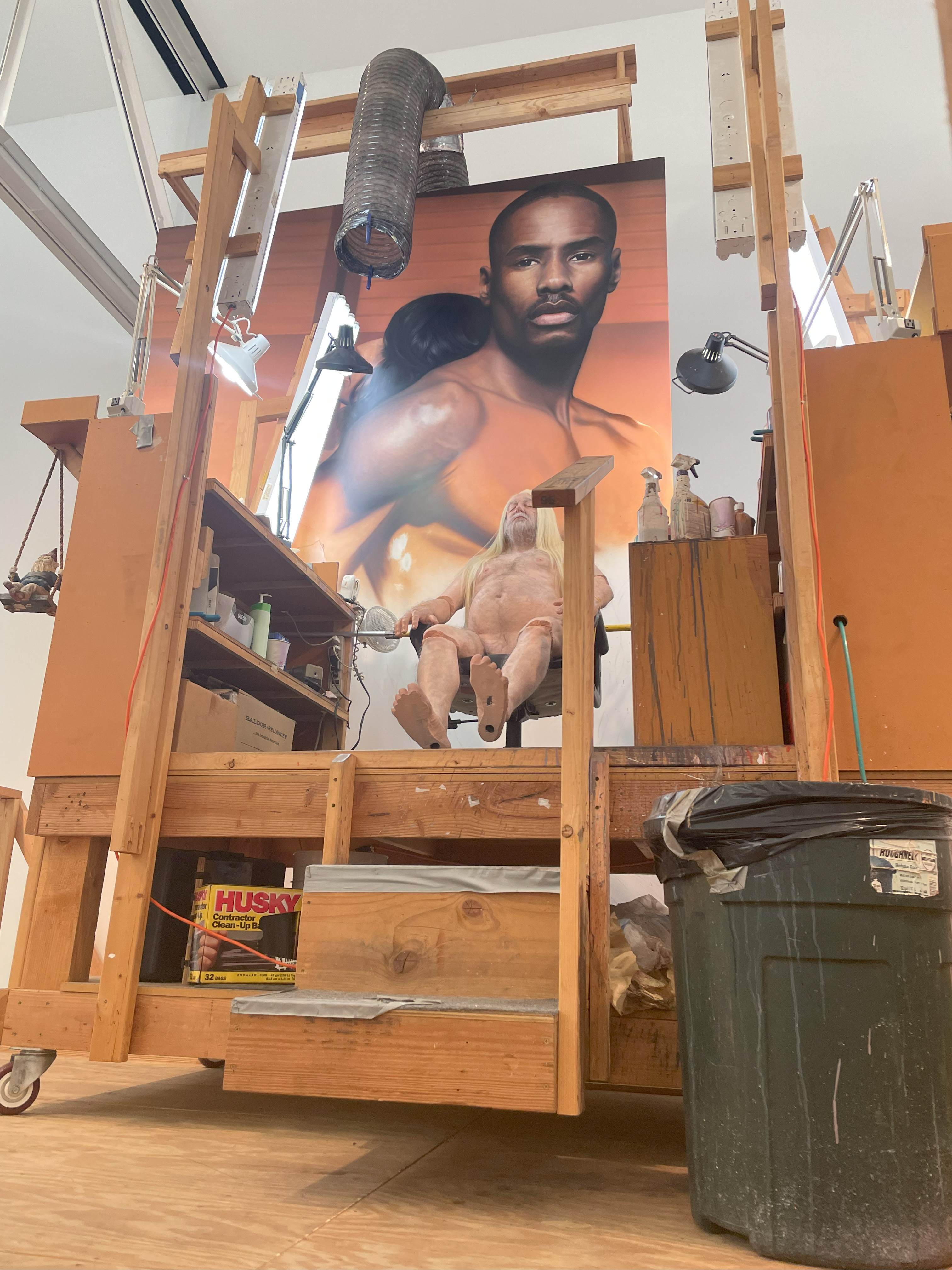Old Cloth
Albert Oehlen and Paul McCarthy at Gagosian
March 8 – May 20, 2023
There it is in the press text: juxtaposed. A word that often implies there is no elaborate concept behind a pairing. But it’s a gallery show — that takes off some pressure. (Ö)Ominously titled “The Ömen,” the show at Gagosian features paintings by Albert Oehlen and sculptures by Paul McCarthy. Affiliation can be enough of a theme for a good show besides the obvious grand painter-sculptor dialectic. McCarthy’s works in the exhibition are almost two decades old. They hail from storage. McCarthy means well, in a hardcore punk kind of way. The lewd way his transgression claims political relevance wasn’t really asked for in recent years. Positions as his are revenants, interpreted as revealing the unconscious of Western society and its mediation. He is likely to have a comeback at some point, though this show might not do the trick. Right now, the market and popular opinion favor the more subjective, self-centered meanness of Jordan Wolfson rather than the more universal sculptural fist fucks of McCarthy.
McCarthy grew up in Utah, the only U.S. state where over 50 percent of the population are members of the Church of Jesus Christ of Latter-day Saints. The sculptures on view — and this is true for most of his works — take something sacred or canonized and debase it; this procedure actually feels most authentic when it results in the truly ugly. His run-down Henry Moore impression doesn’t quite get there; it is pretty and could have been done by a few other artists too. A lot of stuff, when left outdoors to weather, looks stunning housed in the white cube. Works great with paintings, too.
The second of three monumental sculptural works at Gagosian is a naked, relaxed, young female body, possibly that of a teenager, leaning back on their arms with their legs spread and genitals exposed. They are crowned by what looks like a lecherous, bold, big-nosed head of an old man. The head, similar to its material color, is contrasted to the body, aggressively signaling a brutal assembly of desultory parts. One possible narrative is perversely offered by the facial expression: The old gawker lusting after his own teenage body — until the title gives a clinching clue: Paula Jones, Melinda (2004–09). The bold head turns out to be a caricature of Paula Jones, one in a row of women who accused then-sitting President Bill Clinton of sexual harassment. For who Melinda is, one can only assume a more private background. The whole sculpture has an overwhelming and uncanny plastic presence. The skin tone of the body is pink, while the head is yellow, like a part of another plastic toy that the imaginary kid creator stuck on their doll — an idea both harmless and gruesome. The inherent cultural and political menace in this chimera has an irritating attraction. Obviously, McCarthy’s tropes were always somewhat taboo for middle-class taste but somewhat okay in the art world; yet, in the last decade, tables turned and they have also become taboo in the art world. We take a look in our old closet and it hurts. Or, Gagosian, Oehlen, and McCarthy just show us their old closet because one might assume it holds some relevance now. Transness? That would be a cheap shot and guileful even for McCarthy’s oeuvre.
Finally, the last and largest sculpture comes as a whole environment: a historic midwestern Episcopal setting with church benches and a podium, akin to those used for gallows. At its center sits a blond, obese white man—we get the idea—and a painter at that. It is probably a self-portrait of McCarthy as a white Harkonnen king or Jabba the Hutt with painting utensils. Hanging behind him on the wall: a large painting depicting an athletic black man with a near-cropped head of a woman leaning on his strong shoulder painted in a generic air-brushed advertising style. This is not a good painting, the painter is not a good guy, and the deities are replaceable. Leaning on the side wall are wrapped-up paintings depicting an old Western hero, obscene paparazzi pics of Britney Spears, and pornographic imagery. One stands in front of it baffled, mainly given the enormous and forceful materiality, and again for the representation of a taboo with a somewhat unclear vector of aggression. By now some of McCarthy’s works seem like the stereotypical jock seated next to you in the cinema who compulsively, in the best moments, has to say something like, “WHEN DO THEY FUCK?”
